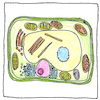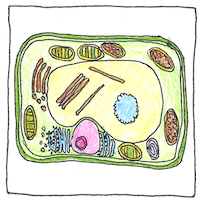Hugo von Mohl,
Jan Evangelista Purkyně,
Thomas Henry Huxley
cell biology

|
Protoplasm
Hugo von Mohl used protoplasm for the “tough, slimy, granular, semi-fluid” in plant cells, not counting the cell walls, nucleus, or vacules. Jan Evangelista Purkyně divided protoplasm in animal cells into cytoplasm around the nucleus and nucleoplasm in the nucleus. Protoplasm was understood to be the principle of life. People thought life was maintained by a non-physical energy and not by physical mechanisms, but Thomas Henry Huxley claimed that protoplasm supported life by molecular forces, that it’s no more meaningful to say that protoplasm contains the principle of life than to say that water contains the principle of aquosity.
Vitalism
A creative force, a spark of life was believed to give each cell its motive force. Otherwise, what would distinguish a living cell from a leaky bag of lumpy juices? The vital principle, moreover, could never be reduced to a physical mechanism. Scientists tried to prove them wrong, assembled the stuff of protoplasm in a test tube, but it didn’t come alive. Some opinions from the eighteenth century seem archaic to us now, but we may still accept that the whole is greater than the parts and that some mysteries remain mysterious.
Ectoplasm
Protoplasm, “first form,” is not to be confused with ectoplasm, “external form,” an alleged form of matter exuded through pores of a psychic medium and draped over spiritual beings to make them visible, but we don’t have anything more to say about that, except that people can call things what they want. The term ectoplasm is also used for the outer portion of the cytoplasm of a cell, which normally wouldn’t involve deception or fakery.



The limits of knowledge are sometimes the limits of our tools. The discovery of the nucleus and the Golgi apparatus required only a microscope; the discover of other things that float in the protoplasm waited until after the invention of the transmission electron microscope in 1931.
See also in The book of science:
Readings in wikipedia: